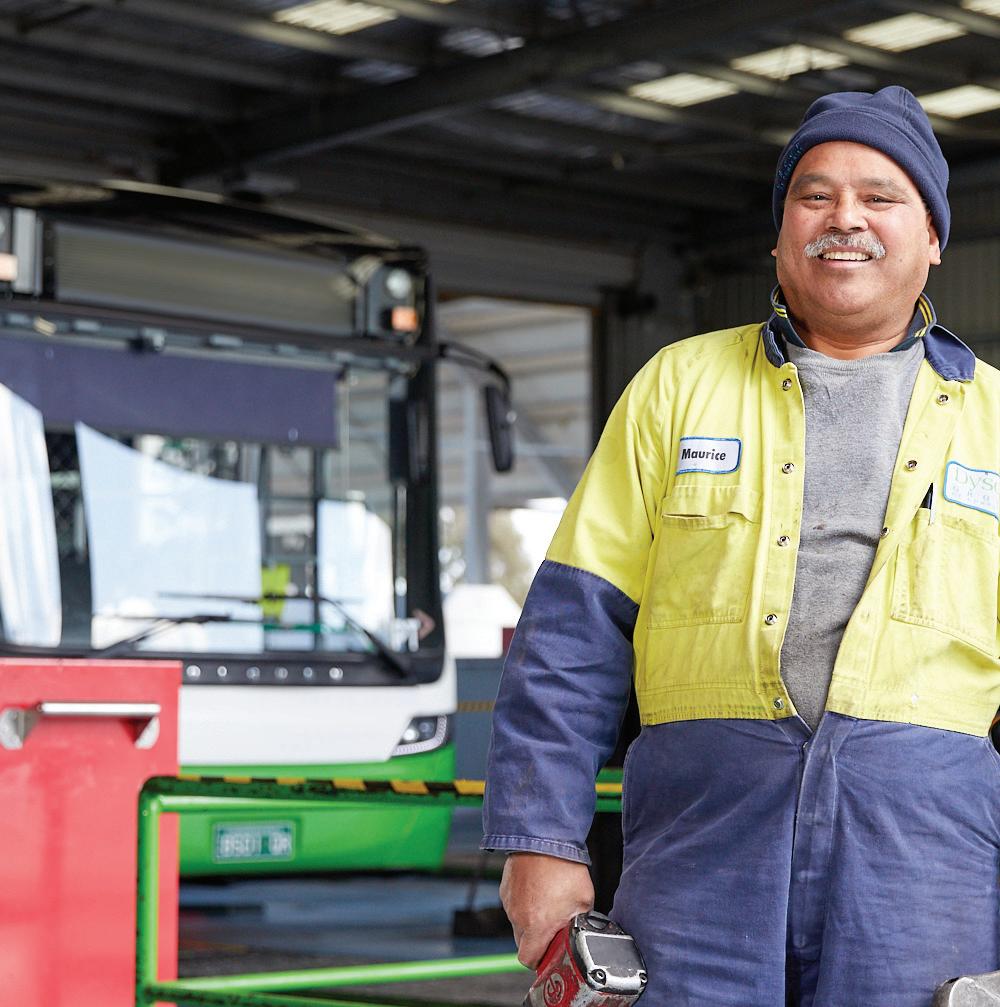
7 minute read
Heavy Vehicle record tumbles in 2022
chain problems.
Four years on from the 2018 high, the record books can be rewritten again. In 2022 there was 44,379 heavy vehicle sales for the year, comfortably surpassing the 2018 mark. In fact, for only the third time ever, the Truck Industry Council’s (TIC) T-Mark sales data shows that over 40,000 trucks and heavy vans were sold in Australia in a single calendar year. The good news is that more new heavy vehicles were put onto our roads in 2022 than in any other previous year. That means more vehicles with the latest safety features, more fuelefficient engines and drivelines, better exhaust emission performance and more higher productivity vehicles. These safer, greener, cleaner and more productive trucks offer all road users improved heavy vehicle safety; they offer all Australians cleaner air to breathe; and they offer operators potential productivity benefits and reduced operating costs. However, despite record, or near record, sales in 2018, 2021 and 2022, we have witnessed the age of the Australian truck fleet steadily grow older, from 14.4 years in 2007 to 15.0 years average age in 2021, as the nation’s freight task continues to grow year-on-year. The bad news is that fleet replacement has not kept pace with this freight growth. While record sales are a starting point, it will in fact take more than a decade of year-on-year record sales for the truck park to return to 14.4 years average age, a number that is twice that of most European countries. A number, that we as a nation, should not be proud of. So why do I mention this, when many might expect celebrations are in order for these new record sales? The answer is simple, the Australian road toll is too high and heavy vehicles are over-represented in those crashes and this is partly to do with the fact that the older trucks in our nation’s truck fleet do not feature the advanced safety features found in newer trucks. Further, Australia’s existing truck fleet is almost 100 per cent diesel-powered. In order to meet our Federal Government’s global greenhouse reduction commitments, operators need to embrace low and zero emission truck technologies when purchasing new trucks.
TIC and our members are very conscious that more must be done to improve heavy vehicle road safety and reduce the carbon footprint of the Australian heavy vehicle fleet and to this end are bringing to market trucks and heavy vans featuring the latest safety and emission technologies, together with an increased range of low and zero emission models. Thus, providing the enabler to better heavy vehicle safety and environmental outcomes. However, government action is also required, after all, government on behalf of the public are undertaking a structural readjustment of the economy in order to meet climate change objectives. TIC calls upon Australian governments at all levels to acknowledge the age of the truck fleet and the associated safety and environmental issues and develop policy, such as the successful instant asset tax incentives deployed by the federal Coalition Government during COVID, that will lead to a positive reduction in our nation’s truck fleet age, an outcome that will benefit all Australians.
Tony McMullan CEO, Truck Industry Council
ANDERSON
It’s terrific to be back writing in these pages and I look forward to engaging with readers over the year ahead on issues of interest to participants in our supply chains, and how, as an industry group, we can work to bring about positive change to benefit freight operators and suppliers.
The year 2022 was punctuated by three key economic events that have combined to put real pressure on our national economy, with consequences for the transport industry.
Soaring inflation, rising fuel costs and a normalisation of interest rates after record lows, are leading to higher business and other costs and operators need to prepare for a reckoning this year. Operators have rightly factored this into their cost models, recognising that wearing higher business charges is fraught with risk and potentially detrimental to their financial health and wellbeing, and their capacity to employ people.
While this undoubtedly contributes to inflation in the broader economy, the VTA continues to advocate for operators to ensure customers and consumers are appropriately charged for what they consume, noting transport accounts for around 12-15 per cent of the total cost of goods sold.
It is encouraging that the Commonwealth is doing its bit to address higher energy costs. Temporary price caps will help to reduce what businesses and consumers pay for energy, freeing up income to maintain
Brace for 2023 economic headwinds
living standards that have been eroding through cost-of-living pressures. We can only hope that as inflation peaks and interest rates stabilises this year, normalcy starts to return after years of turmoil. These are domestic issues we have a degree of control over, however the elephant in the room continues to be geopolitical tensions overseas that has implications for Australia’s supply chains and economic recovery.
Energy costs will continue to be impacted by the ongoing war in Eastern Europe, which we hope will come to a peaceful resolution. Aside from the humanitarian catastrophe, war continues to impact supply chains and commodity prices, with Ukraine’s grains export severely limited, leading to higher prices.
In China, a shift away from a ‘Zero COVID’ strategy has the potential to continue impacting supply chains. Labour shortages there in manufacturing, agriculture, and other sectors due to an expected spike in transmission will inevitably create domestic blockages. Australia is vulnerable to foreign supply chain disruptions, especially in the context of global shipping price hikes and the tyranny of distance we feel as a remote island nation. Shipping lines are either bypassing Australia altogether or are limiting their passage here to reduce costs and as a response to reduced supply.
Our focus this year will be to advocate for the legislation, regulation and reforms that are necessary to respond to these domestic and international pressures, to limit their impact on our industry. We will also continue to pursue reforms that are preventing operators from growing their workforce and solving chronic labour and driver shortages that have plagued the industry.
Through our Victorian Government backed programs, we’ve proved that more intensive and practical-based driver training can produce safer drivers, whilst helping to attract new participants to the transport industry such as people looking for a career change and women returning to the workforce. The next step is to trial the program for young people, including school leavers, which is why we’ve called for a pilot program to accelerate the time to get responsible and capable, and extensively trained young people behind the wheel of heavy vehicles. Training, not experience, should be the benchmark upon which we licence drivers and we will continue our advocacy for this strongly this year.
Notwithstanding these challenges, the future is bright for the Australian transport industry when viewed through the lens of consumption, which continues to grow. The headwinds are there but they are not insurmountable if we work in unison and towards a common goal.
These and numerous other issues will be addressed at VTA State Conference 2023, being held from 19-21 March at Silverwater Resort, Phillip Island. For program information and to register visit www.vta.com.au.
I hope to see you.
Peter Anderson CEO, VTA

Broken Records
initiated as a response to the COVID-induced economic situation, yet there is also an underlying strength in the demand due to the sustained growth of the road freight task which requires additional trucks to move the additional freight.
Despite the enormous impact of the restrictions deemed necessary to weather the COVID storm, Australia managed to achieve a growth in its Gross Domestic Product of 5.9 per cent during 2022. This brings with it the spectre of high inflation, a matter which marketled economies such as Australia and the United States are seeking to address after getting their predictions so very wrong back in 2021, when the RBA and Treasury forecast an inflation rate of just two per cent for 2022, and that it would remain under three per cent for the “next few years”. The RBA currently expects Australia’s inflation to peak at around eight per cent, with the double jeopardy of stagnant wage growth. The dramatic rise in the cost of fuel has been conveniently attributed to the Ukraine war and will continue to be a major driver of inflation across most market sectors. The indications from around mid-year were for 2022 to be a record in terms of truck unit sales, and the December results from the Truck Industry Council show those expectations were well founded.
December’s total of 3,562 new cab chassis and prime movers took the year-to-date accrual to 38,860, an astounding 11.8 per cent increase over 2021 and an 8.9 per cent improvement on the previous record set in 2018. The result comes in spite of challenges in component and labour supply, which have affected all OEMs, some more than others.
Isuzu notched up its 34th year in the top position on the truck sales dais, and the 13,360 new Isuzus delivered during 2022 represent a market share of 34.4 per cent across all categories.
December and January can be a challenging months in the new truck industry due to days lost to gazetted public holidays and the general slowdown during the post-Christmas-New Year break. However, the momentum which has been sustained for most of the year ultimately carried the industry to its best-ever annual result. The big investment Heavy Duty sector added 1,481 new units during December, taking the YTD total to 14,966 — a growth of 15.1 per cent over 2021 (+1,967 units).
Medium Duty added 688 units during December to achieve the total of 7,850 for the year, which is up 6.2 per cent over 2021 (+460 units).
The Light Duty category contributed an additional 1,393 trucks during December to take the total to 16,044 for the year which is 11.8 per cent more than in 2021 (+1,690 units).

At the time of writing there is still some uncertainty in relation to the sunset of the instant asset write-off scheme by 30 June and how that will affect vehicles still having bodies fitted as of that date.
Industry groups have been active in their lobbying to achieve some concessional allowances which hopefully can take into the account the extended times between a formal order for a new vehicle and its actual delivery date.
Dec-22YTD Change













